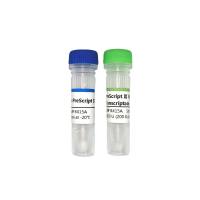Analysis of Plant Gene Expression by Reverse Transcription-PCR
互联网
504
As described in previous chapters (Chapters 15 –23 ), techniques for the measurement of gene expression at the RNA level include RNA gel blot analysis, S1 mapping, primer extension, RNase protection, and, more recently, reverse transcription-polymerase chain reaction (RT-PCR) (1 ). This involves the reverse transcription of total RNA (or mRNA) from which cDNA is synthesized. Primers designed to the target cDNA are then used in a PCR reaction to amplify the desired product. This is then identified by the predicted size of the cDNA on agarose gels with size markers. The identity can also be confirmed by DNA gel blot analysis with a homologous probe or by the use of an end-labeled primer in the PCR reaction from which autoradiographs of gels run with end-labeled size markers that give both a sensitive and accurate determination of product (2 ). This is necessitated when PCR conditions are suboptimal and result in low concentrations of product nonvisible in ethidium bromide stained gels. However, as PCR is a commonly used technique, the need to optimize should not act as a deterrent to the use of RT-PCR. The advantages of RT-PCR include its simplicity in comparison to techniques such as RNase protection and the ability to detect rare transcripts or, similarly, mRNA from small tissue samples. Problems associated with RT-PCR, when the detection of a transcript from transgenic plants is complicated by cDNA copies in genomic DNA contamination of RNA, are discussed in Note 3 .









